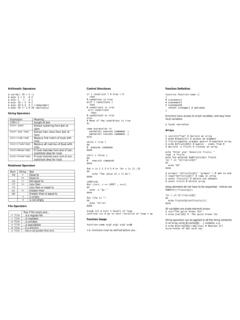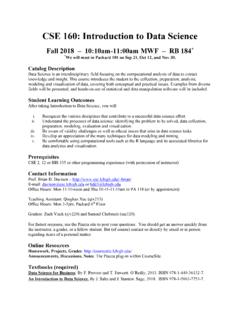Transcription of Organizational Behavior and Organizational Change …
1 Organizational Behavior and Organizational Change Groups & Teams Roger N. Nagel Senior Fellow & Wagner Professor Lehigh University 1. CSE & Enterprise Systems Center Lehigh University Roger N. Nagel 2006. Topics in this Presentation Why people join groups The Five-Stage Model of group Development group Structure: Conformity, Status, Cohesiveness group - Decision Making eleventh edition group - Decision Making Techniques group think, Groupshift Organizational Behavior Interacting Groups Nominal group Technique Brainstorming stephenp. robbins Electronic Meeting 2. Evaluating group Effectiveness Why Have Teams Become So Popular? Organizational Organizationalbehavior . Behavior . Team Versus group : What's the Difference Eleventh EleventhEdition Edition Comparing Work Groups and Work Teams By BySteve SteveRobbins Robbins Types of Teams ISBN.
2 ISBN0-13-191435-9. 0-13-191435-9. A Team-Effectiveness Model Reference ReferenceBook Book Beware: Teams Aren't Always the Answer 2. CSE & Enterprise Systems Center Lehigh University Roger N. Nagel 2006. Groups A group is defined as two or more individuals Interacting and interdependent, who have come together to achieve particular objectives. Groups can be either formal or informal. Members similar or dissimilar 3. CSE & Enterprise Systems Center Lehigh University Roger N. Nagel 2006. Why People Join Groups Security Status Self-esteem Affiliation Power Goal Achievement E X H I B I T 8 1. E X H I B I T 8 1. Page 239. Page 239. 4. CSE & Enterprise Systems Center Lehigh University Roger N. Nagel 2006. The Five-Stage Model of group Development Forming Stage The first stage in group development, characterized by much uncertainty.
3 Storming Stage The second stage in group development, characterized by intragroup conflict. Norming Stage The third stage in group development, characterized by close relationships and cohesiveness. 5. CSE & Enterprise Systems Center Lehigh University Roger N. Nagel 2006. The Five-Stage Model of group Development Performing Stage The fourth stage in group development, when the group is fully functional. Adjourning Stage The final stage in group development for temporary groups, characterized by concern with wrapping up activities rather than performance. 6. CSE & Enterprise Systems Center Lehigh University Roger N. Nagel 2006. The Five-Stage Model of group Development E X H I B I T 8 2. E X H I B I T 8 2. Page 240. Page 240 7. CSE & Enterprise Systems Center Lehigh University Roger N.
4 Nagel 2006. Some Alternatives Groups do not always proceed clearly from one stage to the next. Sometimes several stages go on simultaneously. Groups occasionally regress to previous stages. There are temporary groups as well 8. CSE & Enterprise Systems Center Lehigh University Roger N. Nagel 2006. group Structure - Conformity Conformity Adjusting one's Behavior to align with the standards of the group . Groups place strong pressures on individual to Change their attitudes and behaviors to conform to the group 's standard. Page 248. Page 248 9. CSE & Enterprise Systems Center Lehigh University Roger N. Nagel 2006. group Structure - Conformity Culture bound. Can you suggest other Conformity to social examples? standards is higher in countries with group cultures than in countries with individualistic cultures For example where does leader sit?
5 10. CSE & Enterprise Systems Center Lehigh University Roger N. Nagel 2006. group Structure - Status Status A socially defined position or rank given to groups or group members by others. group GroupNorms Norms group GroupMember Member Status StatusEquity Equity Status Status Culture Culture Page 252. Page 252 11. CSE & Enterprise Systems Center Lehigh University Roger N. Nagel 2006. group Structure - Status Status Groups Important groups to which individuals belong or hope to belong can establish The standards individuals are likely to conform to Planning group Brainstorming group 12. CSE & Enterprise Systems Center Lehigh University Roger N. Nagel 2006. group Structure - Status Status is a socially defined position or rank given to groups or group members by others.
6 What Determines Status? Status derived from one of three sources: 1. The power a person wields over others 2. A person's ability to contribute to group 's goals 3. Individual's personal characteristics 13. CSE & Enterprise Systems Center Lehigh University Roger N. Nagel 2006. group Structure - Status Where managers utilize collective work situations to enhance morale and teamwork They must also provide means by which individual efforts can be identified. 14. CSE & Enterprise Systems Center Lehigh University Roger N. Nagel 2006. group Structure - Status Cultural differences affect status. What are factors create status For example, the French are in your organization? highly status conscious. Countries differ on the criteria . that create status.
7 Status in some USA organizations Position title . Symbols . Office size, desk, window, . parking spot, key to . executive area Access to leaders . Membership on special team Charisma Innovation ability 15. CSE & Enterprise Systems Center Lehigh University Roger N. Nagel 2006. group Structure - Performance Norms Provide explicit ideas for individuals in the group with respect to: How hard they should work, how to get the job done, their level of output, appropriate levels of tardiness, etc. These norms are extremely powerful in affecting an individual employee's performance. 16. CSE & Enterprise Systems Center Lehigh University Roger N. Nagel 2006. group Structure - Cohesiveness Cohesiveness The degree to which members are attracted to each other and are motivated to stay in the group .
8 Cohesiveness is important because it has been found to be related to the group 's productivity. 17. CSE & Enterprise Systems Center Lehigh University Roger N. Nagel 2006. group Structure - Cohesiveness Increasing Increasinggroup groupcohesiveness: cohesiveness: Make Makethe thegroup groupsmaller. smaller. Encourage Encourageagreement agreementwith withgroup groupgoals. goals. Increase Increasetime timemembers membersspend spendtogether. together. Increase Increasegroup groupstatus statusand andadmission admissiondifficultly. difficultly. Stimulate Stimulatecompetition competitionwith withother othergroups. groups. Give Giverewards rewardstotothe thegroup, group ,not notindividuals. individuals. Physically Physicallyisolate isolatethe thegroup.
9 group . 18. CSE & Enterprise Systems Center Lehigh University Roger N. Nagel 2006. Relationship Between group Cohesiveness, Performance Norms, and Productivity E X H I B I T 8 6. E X H I B I T 8 6. Page 255 19. Page 255. CSE & Enterprise Systems Center Lehigh University Roger N. Nagel 2006. group - Decision Making Decision making Large groups facilitate the pooling of information about complex tasks. Smaller groups are better suited to coordinating and facilitating the implementation of complex tasks. 20. CSE & Enterprise Systems Center Lehigh University Roger N. Nagel 2006. group - Decision Making So we agree on new lighting as the solution! 21. CSE & Enterprise Systems Center Lehigh University Roger N. Nagel 2006. group - Decision Making Strengths Weaknesses More complete Lower more time information consuming Increased diversity of Increased pressure to views conform Higher quality of Domination by one or decisions (more a few members accuracy) Ambiguous Increased acceptance of responsibility solutions Page 255.
10 Page 255. 22. CSE & Enterprise Systems Center Lehigh University Roger N. Nagel 2006. group - Decision Making Groupthink Phenomenon in which the goal for consensus overrides the realistic appraisal of alternative course of action. Page 257. Page 257 23. CSE & Enterprise Systems Center Lehigh University Roger N. Nagel 2006. Symptoms Of The Groupthink Phenomenon Members apply direct pressures on those who express doubts about shared views or who question the alternative favored by the majority. Members who have doubts or differing points of view keep silent about misgivings. group members rationalize any resistance to the assumptions they have made. There appears to be an illusion of unanimity. Page 258. Page 258 24. CSE & Enterprise Systems Center Lehigh University Roger N.











